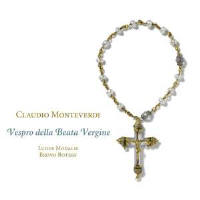Texte paru dans: / Appeared in: Ramée |
|
|
Outil de traduction ~ (Très approximatif) |
|
|
Reviewer: J.
F. Weber
This is somewhat different
than most other versions of the Vespers of 1610 (there are 69 on records by
my count). There are no concertato instruments, hence the omission of the
Sonata sopra Sancta Maria and the use of the Magnificat à 6 rather than the
Magnificat à 7. It is generally assumed that the larger setting, placed
before the smaller one in the print, was intended for First Vespers (the
evening before the feast day and the more splendid celebration), while the
smaller setting would be used for Second Vespers on the following evening.
The players include a continuo group of three along with a sackbut and a
cornett. There are 13 singers, so this is not a one-voice-to-a-part
interpretation. The antiphons for the Common of the Blessed Virgin are sung
framing the five psalms (but only before the canticle, not after), treating
the concertos as supplementary works rather than as antiphon substitutes
(the usual understanding of their purpose).
This is not the first time the
antiphons have been repeated (Harnoncourt and Bardazzi were two who did),
but I called the practice redundant until Boterf came out with the idea that
the concertos are not antiphon substitutes but added motets. Since there is
no concerto after the fifth psalm, two works by Frescobaldi are inserted at
that point. One is an organ toccata before the ricercar, the other a
ricercar for voices and organ (adding sackbut and cornett). Using the same
text, they actually replace the Sonata sopra Sancta Maria. The booklet claims that this is the first recording of the Vespers without concertato instruments. It is not—at least two such versions have been issued. Hermann Max recorded the first one in 1990; I bought it because it was never issued here. Another was recorded by Patrick Dupré Quigley (Fanfare 34:3). Both versions used one voice to a part selectively, adding a large chorus where judged to be needed. Both used the Magnificat à 6 and only a continuo group of instruments, and the sonata was omitted. Max replaced it with the same Frescobaldi ricercar, using only one voice and organ. Even so, both versions fitted on a single disc, whereas Boterf’s does not. The antiphons for Second Vespers of the Blessed Virgin are the same set used by Gabriel Garrido (23:5), although he used the seven-voice setting of the Magnificat where this antiphon for the canticle is incorrect. The same set was used by Diego Fasolis (not reviewed here) and William Christie (22:4) except for using the correct antiphon for First Vespers. Others have used sets of antiphons for various feasts, including the Nativity of the Blessed Virgin (Bardazzi and Pickett), the Annunciation (Rogers and McCreesh), the Assumption (Parrott, Pearlman, and Gini), and even St. Barbara (Savall and Christophers). No matter which set of antiphons is chosen, none of them match the modes of Monteverdi’s psalms. Many have solved that problem, as Denis Stevens first advocated, by choosing a Marian antiphon matching the mode of each psalm—but that is no solution either, for none of the many such efforts has used the antiphons where they belong in their liturgical assignments. García Alarcón, as I said (38:2), cut the Gordian knot by using an appropriate set of antiphon texts and making up chant settings for them using fragments of existing melodies (called centonization in chant circles). Whenever a Vespro is generally satisfactory, as this one is, I go to the deal-breaker in the work, the fiendishly difficult Duo Seraphim for three tenors. Only a few versions can equal the recording under Philip Pickett (14:6), where it actually sounds easy. Apart from this stratospheric standard, the singing and playing is very fine. The sound of sackbut and cornett almost makes one forget the lack of concertato instruments. If the comparisons are limited to Max and Quigley, the former is a very fine interpretation, while the latter has problems that were detailed in the review. One solution is to go for the complete publication of 1610, including both Magnificats and the Missa In illo tempore. We can have Hanns-Martin Schneidt (22:4), the fine Masaaki Suzuki (25:2), Robert King (29:6), and Roberto Gini (34:2) or, lacking the Mass, the first Michel Corboz, the second John Eliot Gardiner (14:5), the Gabriel Garrido (23:5 and 27:1), and the superb Rinaldo Alessandrini (28:4). This is a worthy entry in a very crowded field. | |
|
|
|
|
Cliquez l'un ou l'autre
bouton pour découvrir bien d'autres critiques de CD |
|




